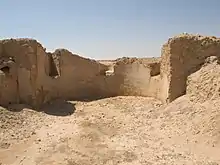Siege of Dura-Europos (256)
The Siege of Dura Europos took place when the Sasanians under Shapur I besieged the Roman city of Dura-Europos in 256 after capturing Antioch.
| Siege of Dura Europos (256) | |||||||
|---|---|---|---|---|---|---|---|
| Part of the Roman-Persian wars | |||||||
| |||||||
| Belligerents | |||||||
| Sassanian Empire | Roman Empire | ||||||
| Commanders and leaders | |||||||
| Shapur I | |||||||
| Units involved | |||||||
| |||||||
| Strength | |||||||
| 23,000 | Unknown | ||||||
Dura-Europos was an important trading center in Roman Syria. It may or may not be the same as the "Doura" recorded in Shapur I's inscriptions. The town was in Sasanian hands for some time after its fall, and was later abandoned. Intact archaeological evidences at Dura provide details of the Roman presence there, and the dramatic course of the siege. The garrison was determined to resist the siege, and the Sasanians employed a variety of siege warfare techniques to defeat them. Archaeological evidences suggest that the garrison at Dura-Europos was mixed, composed of Cohors XX Palmyrenorum (which is known more than the others), vexillations from Legio IV Scythica Valeriana Galliena, III Cyrenaica, XVI Flavia Firma, and other cohorts, including Cohors II Paphlagonum Galliana Volusiana and possibly Cohors II Equestris. The relationship between these forces are uncertain. XX Palmyrenorum was certainly based in Dura-Europos, and may have been an "inferior" contingent of the garrison relative to the legionaries. The numbers of the legionaries are unknown.[2][3][4][5]
The use of chemical weapons
The siege was notable for the early use of chemical weapons by the attacking Persian army. During the siege the attackers dug several underground shaft mines under the city walls. The Romans dug tunnels to reach the mines and fight the diggers underground. In one such tunnel, when the Romans broke through into the Sassanian tunnel the tunnelers ignited a mixture of sulfur and pitch, producing a cloud of sulfur dioxide, which killed twenty Roman soldiers, one of which was carrying a coin dated 256, allowing the dating of the siege. Archaeologists excavated the scene in the 1930s. In 2009 tests showed the presence of sulfur dioxide inside the tunnel.[6][7][8]
Gallery
 Tunnels made by the Sasanians
Tunnels made by the Sasanians Ruins of the city walls
Ruins of the city walls The southern wall. One of the Sasanian assaults was performed against this side of the walls
The southern wall. One of the Sasanian assaults was performed against this side of the walls The citadel
The citadel The citadel
The citadel The praetorium, the headquarters of the legionaries
The praetorium, the headquarters of the legionaries
References
- Encyclopaedia Iranica "The siege of Dura Europos. The Sasanian siege of Dura Europos in 256 brought an end to the town’s existence and immobilized Šāpūr’s army for several months. The determined resistance put up by the inhabitants forced the assailants to adopt various siege tactics, which eventually resulted in conquest of the city"
- Edwell, Peter (2007). Between Rome and Persia: The Middle Euphrates, Mesopotamia and Palmyra Under Roman Control. Routledge. p. 136. ISBN 9781134095735.
- Dirven, Lucinda (1999). The Palmyrenes of Dura-Europos: A Study of Religious Interaction in Roman Syria. BRILL. p. 15, note 56. ISBN 9789004115897.
- Merrony, Mark (2017). The Plight of Rome in the Fifth Century AD. Taylor & Francis. p. 74. ISBN 9781351702799.
- DuBois, Michael (2015). Legio. Lulu.com. p. 254. ISBN 9781329767836.
- “Death Underground: Gas Warfare at Dura-Europos,” Current Archaeology, November 26, 2009 (online feature) http://www.archaeology.co.uk/cwa/world-news/death-underground-gas-warfare-at-dura-europos.htm (accessed October 3, 2014)
- Samir S. Patel, “Early Chemical Warfare – Dura-Europos, Syria,” Archaeology, Vol. 63, No. 1, January/February 2010, http://www.archaeology.org/1001/topten/syria.html (accessed October 3, 2014)
- Stephanie Pappas, “Buried Soldiers May Be Victims of Ancient Chemical Weapon,” LiveScience, March 8, 2011, http://www.livescience.com/13113-ancient-chemical-warfare-romans-persians.html (accessed October 3, 2014).